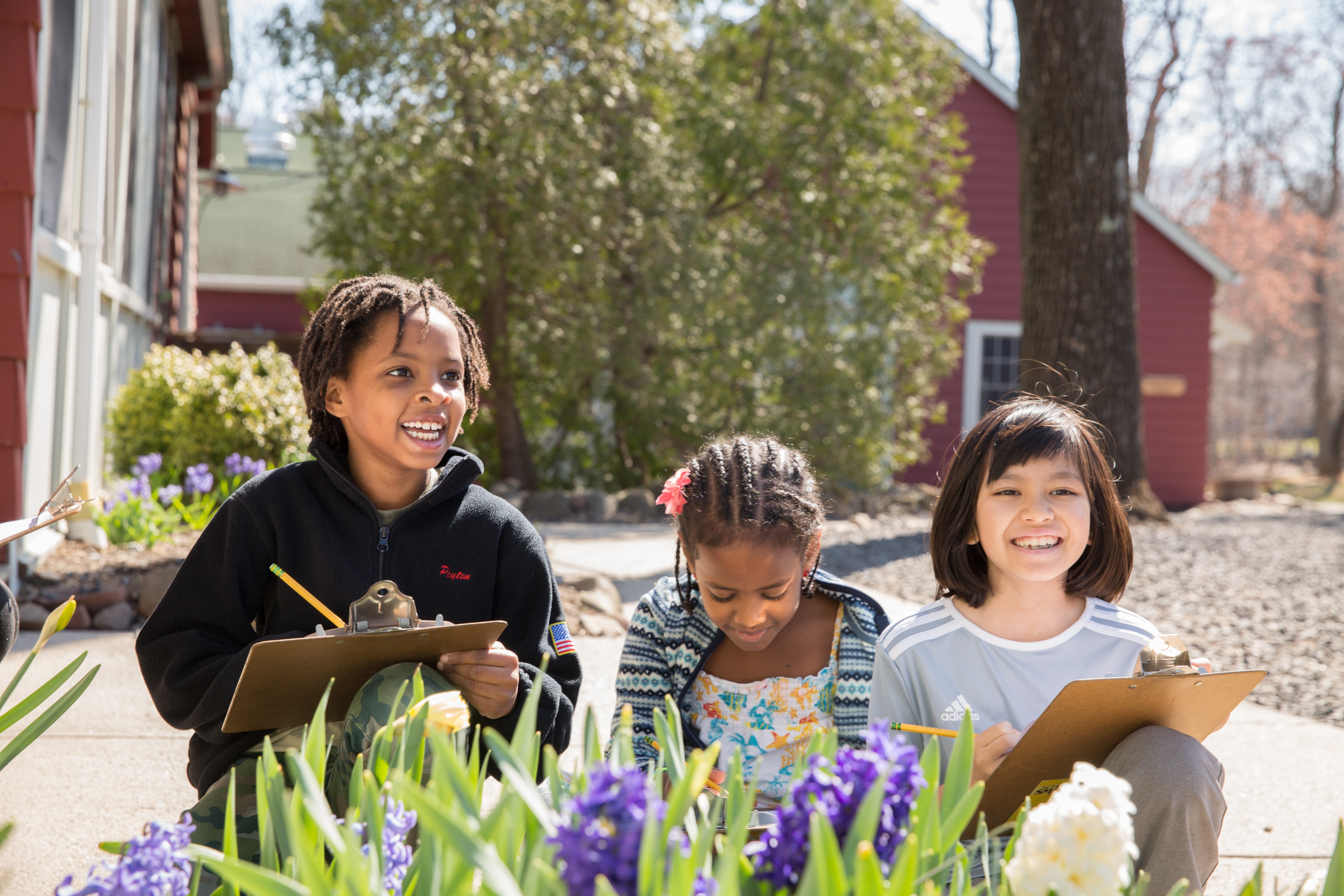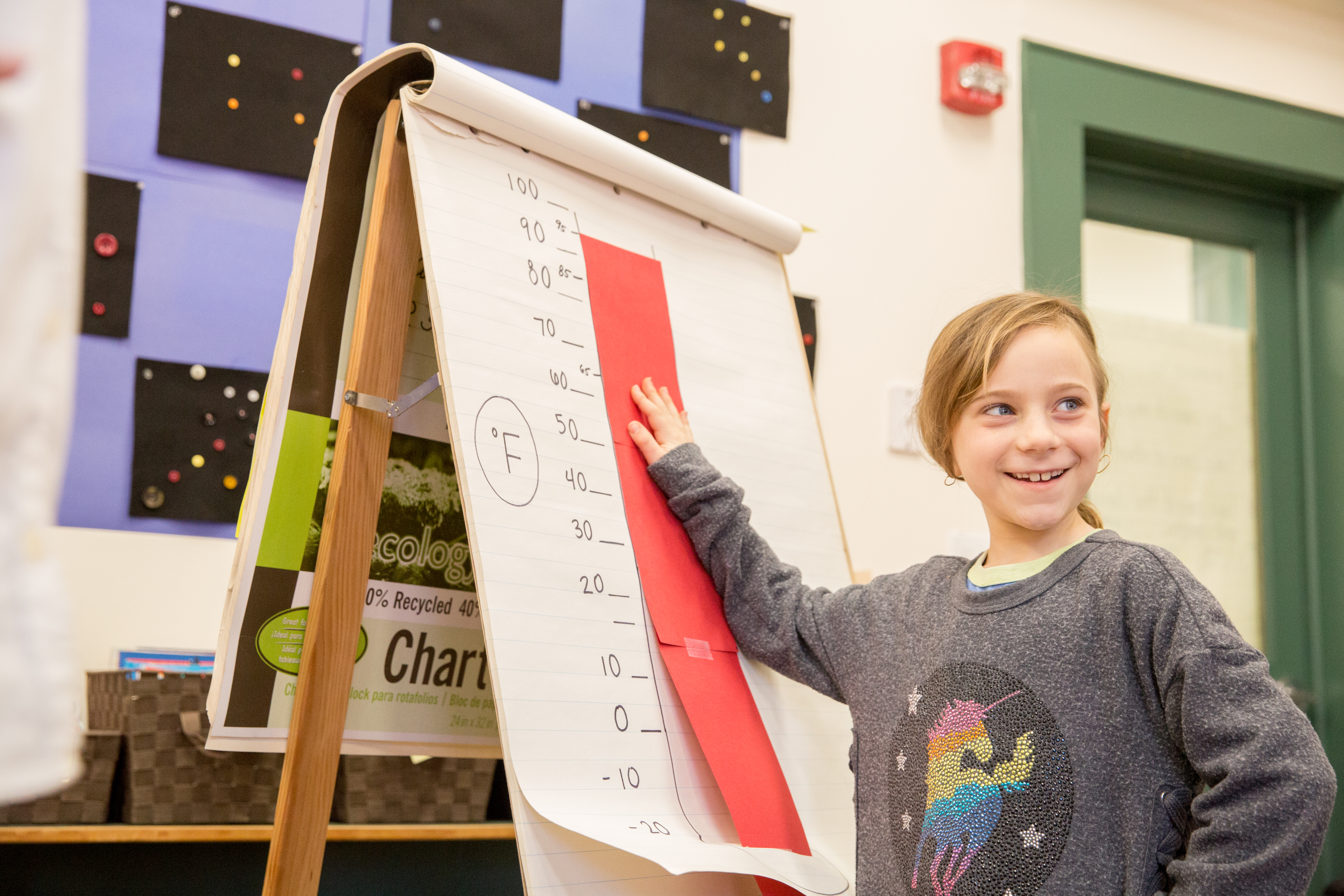Second Grade
Child and Universe: What Makes A Home?
Core Curriculum
Through the Second Grade’s core curriculum, “Child and Universe,” students place themselves in their families, in the wider community, and in the universe to better understand their roles in the world and beyond. Second Graders are learning what it means to be a student and to use their skills in order to further their learning and independence.
The Second Grade study begins with a focus on the children themselves – their interests, joys, and connections to family, friends, school, and the rest of the community. The child’s world is related to the greater universe by experiences with nature, as well as by observations and research about the sun and shadows, stars and constellations, and planets and our solar system. In addition to the strong emphasis on science, children are exposed to myths and legends from diverse cultures that relate to the sun, moon, and stars. Finally, exploration of the Earth and its physical features – continents, biomes and specifically water, its uses, states and sanctity, brings the focus back to the child and their family and connects us in helping others gain access to safe water. Individual families are celebrated throughout Core via family sharing and collections of family stories, which celebrates the diversity of our collective experience.
Literacy
Reading: Continuing Reading Workshop, Second Graders are engaged in a balanced literacy approach that values the development of reading skills and strategies for decoding and also encourages students to find joy, knowledge, and imagination in the books they read. Second graders explore the different purposes of reading and are challenged to grow in their independence, stamina, fluency, and comprehension through small and large group instruction. Students are often led in small guided reading groups in addition to their independent reading.
Writing: Second Grade continues to follow the Writing Workshop approach and engage in purposeful writing units throughout the year-such as personal narratives, fictional stories and research-inspired topics. Poetry is integrated throughout our curriculum as students read, listen to, and write poetry all year. The Second Grade writing program also focuses on skills including spelling, handwriting, and grammar. They are also guided on the mechanics of writing including punctuation and organization.
Library: Second Graders dive more deeply into the genre of contemporary realism, reading and analyzing multiple books about a common childhood experience such as welcoming a new baby to the family or moving to a new home. Students continue to develop their visual literacy skills as they expand from analysis of a picture book’s illustrations to analysis of a graphic novel’s artwork. Second Graders learn how graphic novelists make specific choices about how to use panels, gutters, lettering, angles and framing, and speech/thought balloons to effectively tell their story. Second graders continue to learn how to think like a researcher as they use non-fiction books to check the accuracy of a picture book’s depiction of a particular biome. By the end of second grade, students use their strong stamina to read longer texts to enter the world of chapter books. Students become quite proficient at reading the library’s shelves and spine labels and comfortable to independently browse the collection to find their “just-right” books.
Math
Second Grade uses the Bridges curriculum in mathematics, which focuses on developing students’ deep understanding of mathematical concepts, proficiency with key skills and ability to solve complex and novel problems. Bridges blends direct instruction, structured investigation, and open exploration. It taps into the intelligence and strengths of all students by presenting material that is linguistically, visually, kinesthetically rich as it is mathematically powerful.
Science
Science in Second Grade focuses on the basic components of the universe – rocks, air, water, and light. Topics covered include light reflection and refraction, sound, optical illusions, properties of water and other liquids, magnetism, air pressure, friction, geologic processes, plate tectonics, and properties of rocks. We also explore the ways in which people have changed the Earth through a unit on bridges, considering principles of design, engineering, materials and forces. All topics are explored through simple experiments and hands-on activities with a partner, with a small group, or individually. Emphasis is placed on observational skills, asking questions, drawing conclusions based on data, and recording scientific thinking in different ways. Communication and collaboration are at the heart of Second Grade Science.
Technology
Second grade students meet weekly for a STEAM-focused (Science, Technology, Engineering, Art, Mathematics) class. During STEAM, students are introduced to various computational thinking concepts, such as sequences, decomposition, Booleans, loops, and functions. The class explores these concepts first through a storybook (Hello Ruby: Adventures in Coding) and related activities. Next, students develop their understanding of these concepts in a game-based environment that uses manipulable coding blocks in conjunction with an iPad app (Osmo’s Coding with Awbie). At the end of the year, second graders apply their understanding of computational thinking concepts to coding a robot, which they do in small groups.
World Languages
French and Spanish classes are designed to follow as closely as possible the process by which children acquire their first language. The children are immersed in a language-rich environment made comprehensible through the use of body language, visual aids and abundant repetition in a variety of contexts. The teacher uses mainly story-based activities to bring the language to life. Through careful scaffolding of new and recycled words the children acquire a foundation of basic vocabulary, and simple useful phrases. The underlying teaching philosophy continues to be based on Comprehensible Input. The emphasis is on actively listening, understanding, and responding, as the children engage in simple conversations within the familiar contexts of their immediate environment. A typical lesson may include a variety of story-based and hands-on activities, music, and movement.
Performing Arts
Music: Our music goals in Second Grade are: to build upon the music literacy concepts of solfège, rhythm and form (such as pentatonic scale, half notes); to delve into more sophisticated part work, using ostinatos; to apply this knowledge onto pitched and unpitched rhythm instruments; to engage in critical listening and creative movement using Holst’s The Planets and other works of the classical canon; and to continue our tradition of singing Far Brook songs, folk songs and playground games of North America and cultures around the world, in their original languages. Every student participates in the Lower School Philharmonic, where they explore tonal color through “soundscape” creation and practice complex layering of ostinatos and rhythm patterns, using body percussion and real percussion instruments. The Second Grade makes its formal ensemble debut in Morning Meeting and at Instrumental Night, an evening that features all the instrumental groups of the school. A unit on sidewalk games (clapping, jump rope, ball passing) of North America and from around the world connects with their core curriculum of “Child and the Universe”, allowing the students many opportunities of relating themselves to their ever expanding view of their world.
Dance: Second Graders work to develop skills already gained in previous years, working to develop original choreography in collaboration with others, and taking direction and critiques from the dance teaching artists. Working closely with the classroom curriculum, students explore planets, stars and the solar system, creating movement based on improvisations that imagine the environments in each surrounding. The work created in the Second Grade continues to build upon themes of cooperation, collaboration, self-reflection and personal artistry, while challenging the students with the use of spatial patterning, unison and canon, and the creation of group tableaus.
Junior Strings Orchestra: Students in Grades 1-4 are invited to join the Far Brook Junior Strings Orchestra once they reach a certain level of proficiency in their musical skills with violin or cello. The Orchestra plays in Morning Meeting. Many students who participate in Orchestra also perform in the annual Recital Night in the spring and progress to the more advanced Orchestra for Grades 4-8 which incorporates more students, a wider range of instruments, and more challenging repertoire.
Fine Arts
Art: The Second Grade art curriculum is a visual outgrowth of the “Child and Universe” theme. Second Grade students are encouraged to find and celebrate the artistry of the natural world around them here on Earth. Inspired by the works of Andy Goldworthy, a sculptor and environmentalist, students create ethereal sculptures and 3-dimensional nature-installations around campus made from materials such as stones, branches, leaves, and other nature-made objects. In an effort to raise awareness and be more eco-conscious, students design and create a three-dimensional flower sculpture made entirely out of up-cycled materials; which along with other ‘Earthwork’ installations, brings perennial and sustainable beauty to our outdoor campus.
Design Thinking and Woodshop: Students in Second Grade begin to start thinking more deeply about design and how it can solve problems. Students explore the form and function of furniture and tools – designing objects to fit a certain use. In addition, students create open-ended projects throughout the year.
Social and Emotional
Through weekly classroom meetings, Second Graders continue building upon and practicing the social/emotional skills and strategies they learned in First Grade. The essential skills that are developed relate to five key areas: self-awareness, self-management, social awareness, relationship skills, and responsible decision-making. Children further develop skills needed to be good learners and to form healthy positive relationships.
Sports
Second Grade students continue to refine their motor skills built upon previous years. Team play is introduced and students learn the importance of being a part of a team. A cognitive awareness of sportsmanship is taught and fair play becomes paramount. The teaching of Character development begins and students understand why it is so important in sports as well as life. Second Grade students rotate through units of soccer, floor hockey, team handball, basketball, and kickball/wiffle ball. Every month the students are introduced to a Sports Changemaker — an athlete who makes a difference in the world through fighting for social justice, fairness and equality.



View Curriculum Guide in ISSUU
